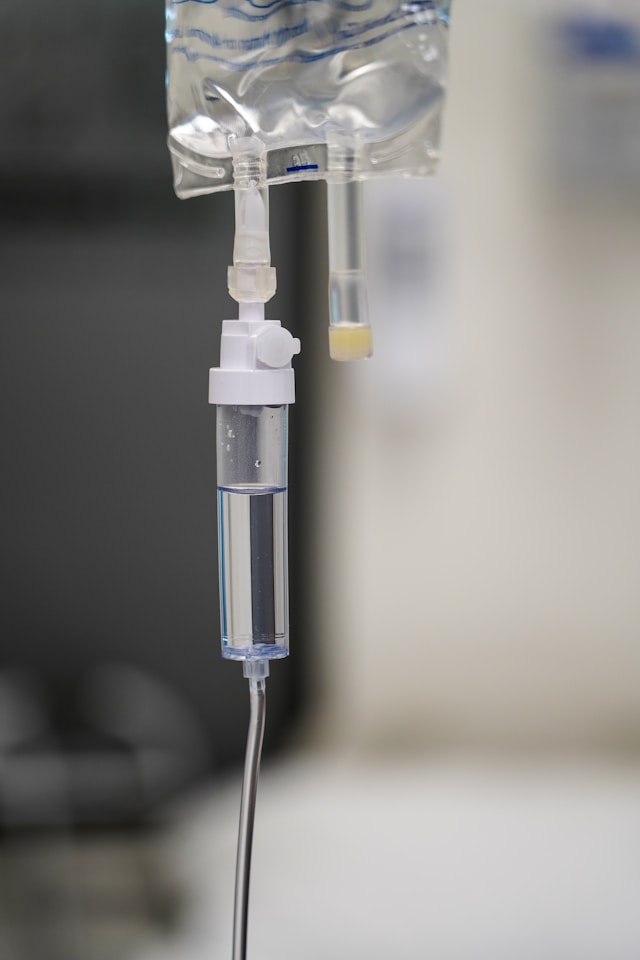
Are Infusions Painful? What Patients Should Know


Dr. Chen is a board-certified immunologist with over 15 years of experience treating autoimmune and immunodeficiency disorders. She specializes in IVIG therapy and has published extensively on immune system treatments.
Medical Disclaimer
If you're preparing for your first infusion, concerns about pain are completely natural. Many patients wonder whether the IV will hurt, if they'll feel the medication going in, or if the treatment itself will be uncomfortable. The good news is that most patients find infusion therapy far less painful than they anticipated. While you may experience some minor discomfort during IV placement, the infusion itself is typically not painful. Understanding what sensations are normal—and which ones warrant speaking up—can help you feel more prepared and confident about your treatment.
Key Highlights
- Most infusion therapy is not painful, though IV placement may cause brief discomfort similar to a blood draw that lasts only a few seconds.
- During the infusion itself, most patients feel little to nothing, though some may notice sensations like coolness at the IV site or mild pressure.
- Serious pain during an infusion is uncommon and should always be reported to your nurse immediately, as it may indicate an issue that can be easily resolved.
The Short Answer: What Most Patients Experience
Infusion therapy is generally not a painful procedure. The vast majority of patients describe their experience as comfortable, with the most notable discomfort occurring during the initial IV placement—a sensation comparable to having blood drawn. Once the IV catheter is in place and secured, most patients report feeling little to nothing during the actual infusion.
According to the Infusion Nurses Society, patient comfort is a primary focus of infusion therapy, and healthcare teams are trained to minimize discomfort at every stage of treatment. Modern IV catheters are thin, flexible, and designed to be as comfortable as possible once inserted.
That said, individual experiences vary based on several factors including your pain tolerance, the specific medication you're receiving, your vein health, and whether you experience any side effects. Being informed about what's normal helps you distinguish between expected sensations and issues that need attention.
What You Might Feel During IV Placement
The moment most patients find least comfortable is when the IV catheter is first inserted into a vein. This process feels similar to having blood drawn—a brief pinch, stick, or stinging sensation that typically lasts only 2-3 seconds.
Here's what happens during IV insertion: Your nurse will apply a tourniquet to make your veins more visible, clean the insertion site with an antiseptic (which may feel cool), and then insert a small needle with a thin, flexible catheter through your skin and into your vein. Once the catheter is in place, the needle is immediately removed, leaving only the soft, flexible tube in your vein.
The initial stick is the sharpest sensation you'll feel. Some people describe it as a quick pinch or bee sting, while others barely notice it. After those first few seconds, the discomfort stops. The catheter itself is so thin and flexible that most patients forget it's there once it's secured with medical tape.
If you have small veins, scarring from previous IVs, or naturally difficult venous access, your nurse may need to try more than one site. While this can be frustrating, experienced infusion nurses are highly skilled at IV placement and will work to make you as comfortable as possible. Let your nurse know if you're nervous about needles or have had difficult IV placements in the past—they can often use techniques like warming your arm, having you drink water beforehand, or taking extra time to find the best vein.
The Mayo Clinic notes that while IV insertion causes momentary discomfort, the sensation is brief and manageable for the vast majority of patients.
What You Might Feel During the Infusion
Once your IV is placed and your infusion begins, you likely won't feel much of anything. Most infusion medications are designed to be comfortable during administration, and serious discomfort during the infusion itself is uncommon.
Some patients report feeling a slight coolness or cold sensation traveling up their arm when the infusion starts. This happens because IV fluids and some medications are stored at cooler temperatures. The sensation is mild and typically fades as your body warms the fluid. A few patients notice a very subtle feeling of fullness or slight pressure in the vein, but this isn't painful—just an awareness that something is flowing through the IV.
Certain medications may cause a metallic taste in your mouth or a slight smell during infusion. While unusual, these sensations are harmless and temporary. Some patients describe feeling the saline flush before or after their medication as a cool or slightly salty sensation—again, not painful, just noticeable.
For the majority of your infusion time, you'll likely be reading, watching something on your device, chatting with a companion, or even napping. Most patients are surprised by how uneventful the actual infusion process feels.
Common Sensations That Aren't Pain
It's helpful to understand the difference between sensations that are normal and those that might indicate a problem. These sensations are common and typically not cause for concern:
Coolness at the IV Site: Feeling cool liquid entering your vein is normal and usually fades quickly. If it bothers you, let your nurse know—they can slow the infusion rate slightly or apply a warm compress to your arm.
Slight Pressure or Fullness: A subtle sense of pressure in the vein where your IV is placed can occur, especially with faster infusion rates. This isn't pain—it's just your body's awareness of the fluid volume.
Tiredness or Drowsiness: Some medications cause fatigue or a relaxed, sleepy feeling. This is a side effect of the medication itself, not an indication of pain or a problem.
Metallic Taste or Unusual Smell: Certain medications can cause brief taste or smell sensations. While odd, these are harmless sensations that resolve after your infusion.
Slight Arm Stiffness: Keeping your arm in one position with an IV can make your arm feel a bit stiff or tired. You can gently move your arm and adjust your position—the IV is secured and won't come out with normal movement.
Warmth or Flushing: Some medications cause a warm, flushed feeling in your face or body. This is typically a side effect rather than pain and should be mentioned to your nurse but isn't usually concerning.
Side Effects vs. Pain: Understanding the Difference
It's important to distinguish between medication side effects and actual pain from the infusion process itself. Side effects come from how your body responds to the medication, while pain from the infusion procedure usually indicates a technical issue with the IV.
Common medication side effects that patients sometimes describe as discomfort include headache, nausea, fatigue, muscle aches, or a general "not feeling well" sensation. These are responses to the medication entering your system, and your healthcare team can often manage them with additional medications or by adjusting your infusion rate.
According to the National Institutes of Health, many infusion medications can cause mild, temporary side effects, but these typically respond well to supportive care and rarely require stopping the treatment.
True pain related to the IV itself—such as sharp, burning pain at the IV site, severe pain traveling up your arm, or intense discomfort at the insertion point—may indicate that the IV has moved, the medication is irritating the vein, or there's swelling at the site. These issues need immediate attention.
When to Tell Your Nurse About Discomfort
Your infusion nurse wants you to be comfortable and needs to know if something doesn't feel right. You should always speak up about:
Sharp or Burning Pain at the IV Site: This could mean the IV catheter has moved or the medication is leaking into surrounding tissue (called infiltration). Your nurse can check the site and may need to restart the IV in a different location.
Swelling, Redness, or Warmth Around the IV: These signs may indicate the IV is no longer in the vein properly or there's irritation occurring.
Pain Traveling Up Your Arm or Into Your Hand: This could suggest the medication is irritating the vein or the IV placement needs adjustment.
Chest Pain, Difficulty Breathing, or Severe Headache: While rare, these symptoms could indicate an infusion reaction and require immediate medical attention.
Severe Nausea, Dizziness, or Feeling Faint: These side effects may be manageable with medications or by slowing your infusion rate.
Any New or Worsening Discomfort: If something feels wrong or significantly uncomfortable, trust your instincts and let your nurse know.
Remember that infusion nurses are experienced professionals who have seen every type of reaction and concern. They won't think you're overreacting or being difficult—they genuinely want to address any discomfort to make your experience as positive as possible. The Cleveland Clinic emphasizes that open communication between patients and infusion staff is essential for safe, comfortable treatment.
How Healthcare Teams Minimize Discomfort
Infusion centers and healthcare providers use numerous strategies to ensure patient comfort throughout treatment:
Skilled IV Placement: Infusion nurses receive specialized training in IV insertion and are highly experienced at placing IVs with minimal discomfort. Many have placed thousands of IVs throughout their careers.
Appropriate Catheter Selection: Nurses choose IV catheters based on your vein size and the type of medication you're receiving, selecting the smallest effective size for your comfort.
Numbing Options: Some centers offer topical numbing cream or cold spray before IV insertion, especially for pediatric patients or adults with needle anxiety.
Optimal Vein Preparation: Techniques like warming your arm with a heating pad, having you drink water before your appointment, or having you make a fist can make veins easier to access and reduce the number of insertion attempts needed.
Pre-Medications: Many patients receive pre-medications like acetaminophen or antihistamines before their infusion to prevent side effects and reactions that could cause discomfort.
Adjustable Infusion Rates: If you experience discomfort related to infusion speed, your nurse can slow the rate. While this extends your treatment time, it may make the experience more comfortable.
Comfortable Environment: Infusion centers are designed with patient comfort in mind, offering reclining chairs, blankets, pillows, and a calm atmosphere to help you relax during treatment.
Continuous Monitoring: Regular check-ins throughout your infusion allow nurses to identify and address any discomfort quickly before it becomes a bigger issue.
Pain Management Options Available
If you're particularly anxious about pain or have a low pain tolerance, discuss options with your healthcare provider before your first infusion:
Topical Numbing Agents: Lidocaine cream or spray can be applied to the IV site before insertion to minimize the stick sensation.
Distraction Techniques: Many patients find that looking away, taking deep breaths, or focusing on conversation helps minimize the discomfort of IV placement.
Anxiety Management: If needle anxiety is significant, talk to your doctor about whether a mild anti-anxiety medication before your appointment might be appropriate.
Post-Infusion Support: If you experience headaches or body aches after infusions, your doctor may recommend over-the-counter pain relievers or prescribe preventive medications.
Alternative IV Sites: If arm veins are painful or difficult to access, some patients may have IVs placed in their hand or, for long-term therapy, consider a port (a surgically placed device that provides easy IV access without repeated needle sticks).
What Patients Say About Their Experience
While everyone's experience is unique, most patients report that infusion therapy was less uncomfortable than they expected. Many describe their main takeaway as "It wasn't as bad as I thought it would be."
Patients commonly share that the anticipatory anxiety about pain was worse than the actual experience. The brief discomfort of IV placement is often described as "totally manageable" or "over before I knew it." During the infusion itself, most patients say they felt comfortable enough to relax, read, work on their devices, or even sleep.
Some patients do experience medication side effects like fatigue, headache, or nausea, but they generally distinguish these from pain related to the infusion procedure itself. Many find that side effects decrease with subsequent infusions as their bodies adjust to the medication, or they can be managed with pre-medications and hydration.
Long-term infusion patients often describe their treatments as routine appointments that fit into their normal lives rather than painful or dreaded experiences. The relief from symptom control typically far outweighs any minor discomfort associated with the treatment process.
Frequently Asked Questions
Does getting an IV for an infusion hurt?
IV placement causes brief discomfort similar to a blood draw—typically described as a quick pinch or sting that lasts only 2-3 seconds. Once the IV catheter is in place, the discomfort stops. Most patients find IV insertion manageable, especially when they look away and take deep breaths during the process.
Can you feel the medication going into your veins?
Most patients don't feel the medication entering their bloodstream. You may notice a cool sensation at the IV site if the medication was refrigerated, or very rarely a subtle feeling of pressure, but these sensations are mild and not painful. The majority of patients feel nothing at all during their infusion.
What does an infusion reaction feel like?
Infusion reactions vary but may include itching, rash, warmth or flushing, headache, nausea, shortness of breath, or changes in blood pressure. These are different from pain at the IV site and represent your body's response to the medication rather than the infusion process itself. Reactions are monitored closely and can usually be managed by slowing the infusion or providing additional medications.
How painful is IVIG infusion?
IVIG infusions are typically not painful during administration. The IV placement causes brief discomfort, but the infusion itself usually doesn't hurt. However, some patients experience headaches during or after IVIG infusions, which is a side effect of the medication rather than pain from the infusion process. These headaches can often be prevented or treated with hydration, slower infusion rates, and pain relievers.
Will my arm be sore after an infusion?
Some mild soreness or a small bruise at the IV site is normal and usually resolves within a few days. This is similar to the minor soreness you might experience after having blood drawn. Significant pain, swelling, or increasing redness after you leave the infusion center should be reported to your healthcare provider, as these could indicate a complication that needs attention.
You Can Approach Infusion Therapy with Confidence
Understanding what to expect in terms of pain and discomfort can significantly reduce anxiety about infusion therapy. While everyone's experience is slightly different, the vast majority of patients find that infusion therapy is a comfortable, manageable treatment that provides significant relief from their underlying condition.
Remember that your healthcare team is there to support you and address any concerns or discomfort you experience. Open communication ensures you receive the most comfortable care possible.
Ready to find an infusion center with experienced, compassionate staff? Explore infusion centers near you to begin your treatment journey with confidence.
Medical Disclaimer: This content is for educational purposes only and is not a substitute for professional medical advice, diagnosis, or treatment. Always consult your healthcare provider with questions about your medical condition or treatment options.
Article Statistics


Table of Contents
Article Statistics










